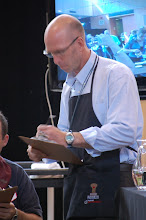I've felt the need to dig a little deeper into Manual Brew Costing since it is a relatively new revenue stream for many coffee shops, and very different metrics apply to determining it's profitability. I really appreciated the comments, and hope to provide some more info for discussion. So here goes my second instalment in a complete workup of Manual Brewing.
My first assumption is that Batch Brewing and Manual Brewing are perfect substitutes from the consumers perspective. That means that a customer would be equally happy ordering a manual brew coffee and a batch brewed coffee in most circumstances.
Second, I am assuming that most customers are accustomed to ordering their coffee as a batch brew, and therefore it is the default order for most customers. Because it is the default, most customers are acquainted with "normal" wait times when ordering a batch brew, and are familiar with normal pricing associated with it. This is important because if Batch Brewing is the default, the exogenous inputs of "Wait time" and "Price" affect only Manual Brewing.
Using these assumptions I have come up with the following equation to represent the consumers demand for Batch Brewed and Manual Brewed Coffee:
Demand for Coffee = Brewed Coffee + (Manual Brewed Coffee/Wait Time and Price)
In this equation, the + sign indicates that both are substitutes for each other and combined demand equals total demand for coffee. (I understand that in parts of Europe the Americano factors strongly, but I'll examine that at a later date.)
It has been pointed out to me that Intelligentsia is successfully using all manual brewing and achieving a high profit through efficiency by brewing approximately 4 brews in 6 minutes negating my 7.5 minute assumption. I spent some time thinking about this, and of course came to the conclusion that efficiency is best met when output is maximized, ie a busy shop like Intelligentsia. So the question is how can a smaller operation achieve the same efficiency? I think the equation provides some revealing info.
If Brewed and Manual are perfect substitutes, then eliminating one simply means more volume of the other. If a shop eliminates Batch Brewed (like Intelli) the full volume shifts to Manual Brewed where there is the possibility of achieving efficiency though volume. Further, because there is no Batch Brewed Coffee, the expectations for speed and pricing may be altered negating the drag on demand by the denominator in the equation. (Assuming there isn't a super fast direct competitor next door tempting impatient customers away) In the equation, the default was Batch Brewed, and the drag was placed on Manual because it introduced unfamiliar inputs of extra time and elevated price. However, eliminate Batch, and the default changes to Manual. I expect that there would need to be a transition period where staff would build skill levels and determine best sequencing, as well as a period of preparing customers for a change. I still have serious reservations about whether cost effective manual brewing is possible in most situations, but am intrigued.
I'm sure Intelligentsia went through this exercise, but thinking through it step by step helped me realize that perhaps in the right circumstance, labour can be applied efficiently in Manual Brewing. I will sit on this for a few days and expand on it by costing a manual brew only shop with quicker brew times and maybe an equation that capture the Supply side of the transaction.
Please share your comments, they help me work through things I hadn't thought of and bring different perspectives to an important subject.
Sunday, February 6, 2011
Subscribe to:
Post Comments (Atom)





No comments:
Post a Comment